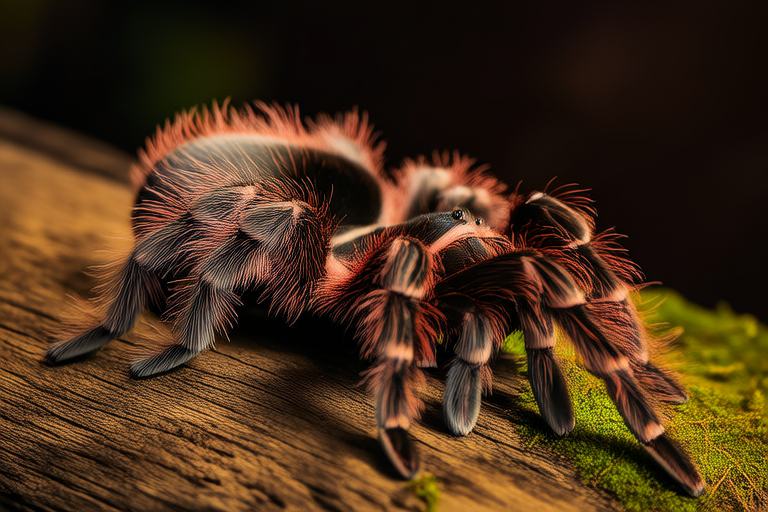Spider Sensations: Unique Insights into Living with Your Own Tarantula
Tarantula Species Diversity
Tarantulas, members of the Theraphosidae family, are among the most diverse and fascinating arachnids in the world. With over 900 species identified, these spiders come in various sizes, colors, and temperaments. From the vibrant reds and blues of the Mexican Redknee Tarantula (Aphonopelma chalcodes) to the burrowing prowess of the Brazilian Giant Whiteknee Tarantula (Aphonopelma robustum), each species offers a unique experience for pet owners.
Some species, like the Chilean Rose Tarantula (Grammostola rosea), are ideal for beginners due to their docile nature and ease of care. Others, such as the Goliath Birdeater (Theraphosa blondi), are better suited for experienced keepers because of their size and specialized requirements.
Housing and Habitat Setup
Creating the right environment for your tarantula is crucial for its health and happiness. The enclosure should be spacious enough for the spider to move around comfortably. A general rule of thumb is that the tank should be at least three times the length of the spider’s leg span.
Substrate is key; it should be able to hold moisture well and allow for burrowing if desired. Coconut fiber, peat moss, and cypress mulch are popular choices. Keep the substrate moist but not soggy to mimic the spider’s natural environment.
Temperature and humidity also play significant roles. Most tarantulas thrive in temperatures between 75°F and 85°F (24°C to 29°C) and humidity levels ranging from 60% to 80%. Proper ventilation is necessary to prevent mold growth and ensure air circulation.
Dietary Needs
Tarantulas are carnivorous and require a diet rich in protein. In captivity, they can be fed crickets, mealworms, and dubia roaches. The size of the prey should match the spider’s mouthparts, ensuring easy consumption without causing injury.
Feeding frequency varies depending on the age and size of the tarantula. Younger spiders may need to eat once or twice a week, while mature adults can go for several weeks between meals. Always provide fresh water in a shallow dish; tarantulas drink by dipping their fangs into standing water.
Handling and Interaction Tips
While tarantulas can be handled, it requires careful technique and understanding of the spider’s behavior. Start by gently coaxing the tarantula onto your hand using a stick or other non-threatening tool. Once on your hand, support the spider’s abdomen with your other hand to avoid stressing it.
Interactions should be kept brief and infrequent, as tarantulas are solitary creatures that prefer solitude. Over-handling can lead to stress and potential molting issues. Always wash your hands before and after handling to maintain hygiene and reduce the risk of transferring oils or chemicals.
Common Myths Debunked
One of the most prevalent misconceptions about tarantulas is that they are aggressive and dangerous. While all tarantulas have venom, it is generally harmless to humans, similar to a bee sting. Their primary defense mechanism is to flee or flick urticating hairs from their abdomen, which can cause irritation to skin and eyes.
Another myth is that tarantulas live only a few years. In reality, many species can live up to 20 years or more. Providing proper care and a healthy environment significantly extends their lifespan.
Personal Anecdotes from Tarantula Owners
John, a seasoned tarantula keeper, shares his experience, “My first encounter with a tarantula was daunting, but once I learned how to handle them, I realized they’re incredibly peaceful creatures. Watching my Chilean Rose molt is one of the most fascinating experiences.”
Sarah, another enthusiast, adds, “What I love most about owning a tarantula is the bond you can develop. They might not be cuddly, but there’s something special about knowing your spider is comfortable and thriving in its home.”
Emphasizing Safety, Care Instructions, and the Unique Bond
Caring for a tarantula is a rewarding endeavor that requires patience and dedication. Ensuring their habitat is correctly set up and maintaining a consistent feeding schedule are essential for their well-being. By providing the right conditions, you foster a safe and nurturing environment where your tarantula can grow and thrive.
The unique bond formed with these creatures is profound. Each interaction, whether it’s observing their natural behaviors or assisting during a molt, deepens this connection. Owning a tarantula is not just about having an exotic pet but about learning to appreciate the beauty and complexity of these incredible animals.
